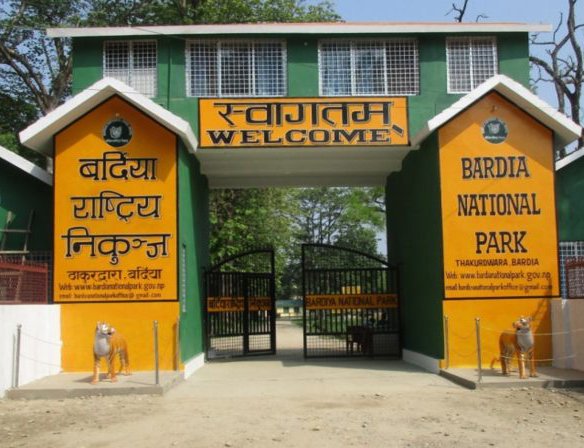
Bardia National Park and Banke National Park are two major national parks located in Lumbini Province of Nepal. Both national parks are known for their diverse wildlife and natural beauty. The approximate distance between Bardia National Park and Banke National Park is about 20 to 30 km depending on the different locations within the parks. Travel time by motor vehicle between the two parks by road is about 1 to 1.5 hours. As both are in Terai region and have similar flora and fauna, both parks have similar characteristics. Their proximity makes it easy for tourists and explorers to explore both parks during their visit to the region. Based on the same natural and geographical structure as well as proximity, these two parks can be called twin national parks.
Bardia National Park:
Bardia National Park is in the Terai region of western Nepal, covering an area of about 968 square kilometers. It is one of the largest and least disturbed national parks in the country. The park is bordered by the Karnali River to the west and the Babai River to the east.
Wildlife: Bardia National Park is home to a wide variety of wildlife, including Bengal tigers, Asian elephants, one-horned rhinoceros, swamp deer, wild boar, and spotted deer. It is also home to many species of birds, making it a great destination for bird watchers.
Vegetation: The park consists of a mixture of grassland, savanna, and riparian forest habitats. The diverse vegetation provides suitable environments for different species of wildlife.
Activities: Visitors to Bardia National Park can enjoy activities such as jungle safaris, elephant rides, bird watching, nature walks, and boat trips on the Karnali and Babai rivers. These activities provide opportunities to observe wildlife in their natural habitat.
Banke National Park:
Banke National Park is in the mid-western region of Nepal, covering an area of approximately 550 square kilometers. It was established in 2010, making it one of the newer national parks in Nepal.
Wildlife: The park is home to diverse wildlife, including the Bengal tiger, one-horned rhinoceros, wild elephant, swamp deer, hog deer, and numerous bird species. The park's location in the Terai region provides a suitable habitat for a variety of animals and birds.
Vegetation: Banke National Park consists of tropical and subtropical forests, grasslands, and riverine habitats. The vegetation in the park supports its rich biodiversity.
Activities: Like Bardia National Park, visitors to Banke National Park can participate in jungle safaris, birdwatching, and nature walks to observe wildlife and explore the natural surroundings.
Both Bardia and Banke National Parks are essential conservation areas in Nepal, contributing to the protection of endangered species and preserving the unique ecosystems found in the region. They also offer exciting opportunities for eco-tourism, providing visitors with memorable wildlife experiences and a chance to connect with nature in a pristine environment.
Buffer zones in the twin national parks
Buffer zones in national parks are areas of land surrounding the core protected area that serve as a transitional zone between the wilderness of the park and the human-dominated landscapes outside. These buffer zones are an essential component of conservation strategies and aim to strike a balance between wildlife conservation and the sustainable use of natural resources by local communities.
In the context of national parks in Western Nepal, including Bardia and Banke National Parks, buffer zones play several critical roles:
Biodiversity Conservation: Buffer zones provide a buffer between human settlements and the core area of the national park. This helps reduce human-wildlife conflicts and provides a space for wildlife to move freely and maintain their natural behaviors.
Livelihood Opportunities: Buffer zones can be managed in a way that supports sustainable livelihood opportunities for local communities living in the vicinity of the national parks. This can include eco-tourism, community-based natural resource management, and sustainable harvesting of forest products.
Cultural Heritage Preservation: Many buffer zones are inhabited by indigenous and local communities with unique cultural practices and traditional knowledge. Preserving their cultural heritage is an integral part of conservation efforts in these areas.
Environmental Education and Awareness: Buffer zones provide an opportunity to engage local communities and visitors in environmental education and awareness programs. This helps foster a sense of stewardship and understanding of the importance of conserving the national park's biodiversity.
Research and Monitoring: Buffer zones can serve as a site for scientific research and monitoring of wildlife and ecosystem dynamics. Studying the interactions between humans and wildlife in these areas can provide valuable insights into conservation strategies.
Conflict Mitigation: Human-wildlife conflicts, such as crop raiding by elephants or predation on livestock, are common in areas surrounding national parks. Properly managed buffer zones can help mitigate such conflicts through measures like electric fencing and community-based deterrence strategies.
The establishment and management of buffer zones in national parks in Western Nepal represent a proactive and holistic approach to conservation that recognizes the importance of both wildlife protection and the well-being of local communities. Through well-designed buffer zone management plans, these national parks can serve as models for biodiversity conservation and community development.
(The author is a communication expert)













